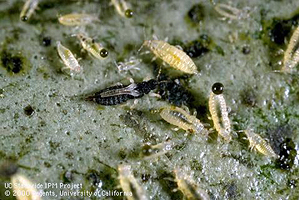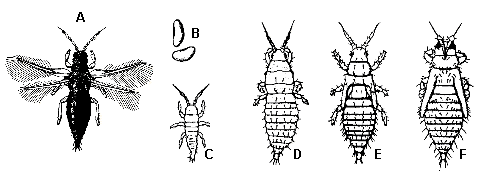|
|
Back to Pest Identification and Diagnosis
GREENHOUSE THRIPS
SCIENTIFIC NAME: Heliothrips haemorrhoidalis (Bouche)
CLASS:
Insecta
ORDER:
Thysanoptera
FAMILY: Thripidae
 |
 A. Adult B. Egg C-D. Larvae E. Prepupa F. Pupa |
|
|
Black Adult and Yellow Nymphs From: University of California |
Life Cycle From: NC Extension |
| DESCRIPTION | |
|
Adults: The head and central area of the body have a distinct network of lines. The body is dark brown with the posterior end much lighter; the legs are uniformly yellow; the wings are hyaline and narrow, but with a broad base; and the antennae are slender with a characteristic needle-like tip. The mature adults are about 1.3 to 1.8 mm long. The male is similar to the female thrips, but slightly smaller. Eggs: The eggs are very small, banana-shaped, and white. Larvae: The first larval instar is white; the second instar is yellow. Both instars have red eyes. Pupae and Prepupae: The pupa and prepupa do not move about freely. These stages are yellowish with red eyes. Pupae are slightly larger, with longer wing pads, and antennae bent back over body. They become darker with age. |
|
| BIOLOGY | |
|
Distribution: Although the greenhouse thrips is limited to tropical areas outside, it is found throughout the world in greenhouses. This thrips probably originated in Central and South America. Host Plants: The greenhouse thrips has over 100 hosts, principally greenhouse and ornamental plants, but also a few crops and tropical plants. Some of the hosts are azalea, begonia, croton, cyclamen, ferns, fuchsia, grape vines, orchids, palm, and rose. Damage: This thrips feeds almost entirely on the foliage, and large populations cause severe damage. Greenhouse thrips usually injure inner leaves and fruit. Damaged leaves appear silvery or bleached and, if the damage is severe enough, turn yellow and drop. Fruit that has been attached is brown, cracked, and has noticeable sunken areas. Dark spots of excrement are often noticeable on the leaves and fruit. Life Cycle: Each female deposits 25 to 50 eggs in slits in the leaves. Under optimum conditions the time for development is 17 to 20 days for the eggs, about 13 days for the two larval instars, and about 5 days for the prepupal and pupal stages. The adults can live 7 weeks on plants growing in the greenhouse. All stages can be found throughout the year in greenhouses. Greenhouse thrips move relatively slowly and rarely fly. They prefer a cool, shady, and fairly moist atmosphere. These thrips feed in colonies on the foliage and fruit. They select neither the youngest nor the oldest leaves on which to feed. Often the fruit is preferred to the leaves. Since males are not common, reproduction is usually by parthenogenesis (laying unfertilized eggs). Males were first found in 1940. |
Back to Pest Identification and Diagnosis
 |
(C) Regents of the University of
Minnesota. All rights reserved. |
 |
 |